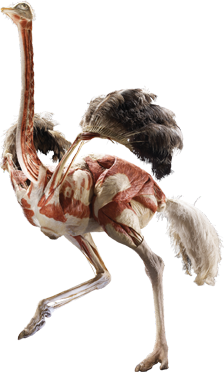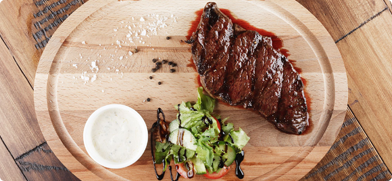
Ostrich Meat - Savoury and Delicious!
With its combination of great taste and nutrition, and it's incredible ease and versatility in cooking, ostrich meat has rapidly found its' way onto the menu of many of the finest restaurants in the world.
If you've never tried ostrich meat, you're missing a treat! Ostrich is like premium beef in taste and texture. It grills like any lean steak, and because it is so lean you will not see any shrinkage during cooking and have more meat to enjoy!
Ostrich meat is iron rich, and it is a great way to reduce your fat and cholesterol intake – while still giving you an awesome, savoury, meaty meal. When it comes to the combination of great taste and healthy eating, ostrich is truly one of the most superior meats. It's even lower in fat than white meat chicken or turkey.
Ostrich Steaks – Red meat from a bird?
Ostrich meat doesn't taste like “other birds” because it is not a bird at all. Its meat is red like venison and the taste is similar to prime beef. Others say it tastes like veal. You have to try it for yourself and come to your own conclusions. We would like to hear what you have to say about the taste of ostrich.
Cooking Ostrich Meat
Ostrich is a healthy and tasty substitute for any red or white meat. Use it in your favourite recipes. It absorbs seasonings and marinates rapidly.
Since ostrich meat is so lean, you need to be careful not to overcook it. The recommended preparation or this red meat is medium or medium-rare - just like a premium steak.
Health benefits
Ostrich is even lower in calories, cholesterol and fat than skinless chicken and turkey, while remaining high in iron and protein.
The Diabetes Association approves and recommends ostrich as a leading source of protein. It has also been approved by the American and British Heart Associations.
What’s more, due to ostrich's ideal pH balance, the meat does not attract harmful bacteria like E.coli or salmonella. Tasty and healthy!
The meat is very easy to prepare
Never cook ostrich more than to medium. It should be red in the center when you cut into it. Use low temperature and moisture when roasting. Ideal internal temperature when a roast is ready is 160 ° F. Ostrich meat has no bones and no shrinkage. We suggest that you brown both sides over high heat (broil, fry, BBQ) and then continue cooking over lower heat until you get it the way you like it. (Rare to Medium recommended).
Most ground meats recipes advise you to drain the fat when sautéing ground meat, but ostrich ground meat is so lean there is no fat to drain. Ground Ostrich, can be used in any recipe calling for beef. Make chili, spaghetti sauce, delicious lasagna, or use it for any casserole.Most ground meats recipes advise you to drain the fat when sautéing ground meat, but ostrich ground meat is so lean there is no fat to drain. Ground Ostrich, can be used in any recipe calling for beef. Make chili, spaghetti sauce, delicious lasagna, or use it for any casserole.
This food is a good source of:

- Protein
- Vitamin B6
- Vitamin B12
- Iron
- Thiamin
- Riboflavin
- Niacin
- Phosphorus
- Zinc
- Selenium
- and more.
Ostrich patties provide a healthy alternative to regular hamburger patties, and many people consider them tastier and more interesting than poultry. An ostrich patty contains 22 g of protein, nearly half your daily protein allowance, in each serving. One serving of ground ostrich delivers 84 percent of your daily vitamin B-12, 51 percent of your selenium and about one-quarter of your daily niacin, vitamin B-6, phosphorus and zinc. It contains smaller but significant levels of thiamin, riboflavin, pantothenic acid, iron, potassium and copper.Ostrich patties provide a healthy alternative to regular hamburger patties, and many people consider them tastier and more interesting than poultry. An ostrich patty contains 22 g of protein, nearly half your daily protein allowance, in each serving. One serving of ground ostrich delivers 84 percent of your daily vitamin B-12, 51 percent of your selenium and about one-quarter of your daily niacin, vitamin B-6, phosphorus and zinc. It contains smaller but significant levels of thiamin, riboflavin, pantothenic acid, iron, potassium and copper.